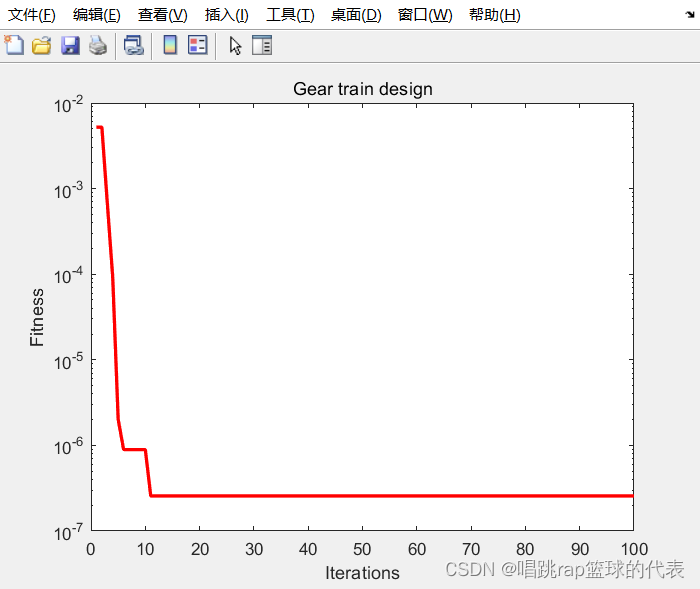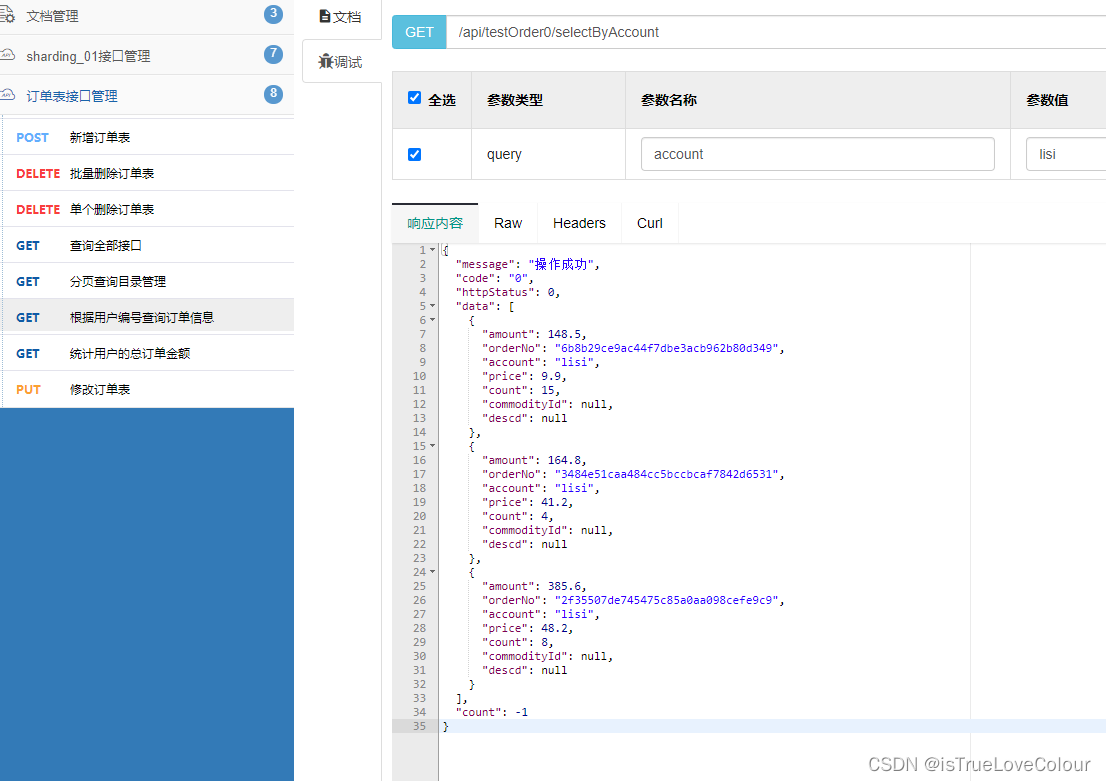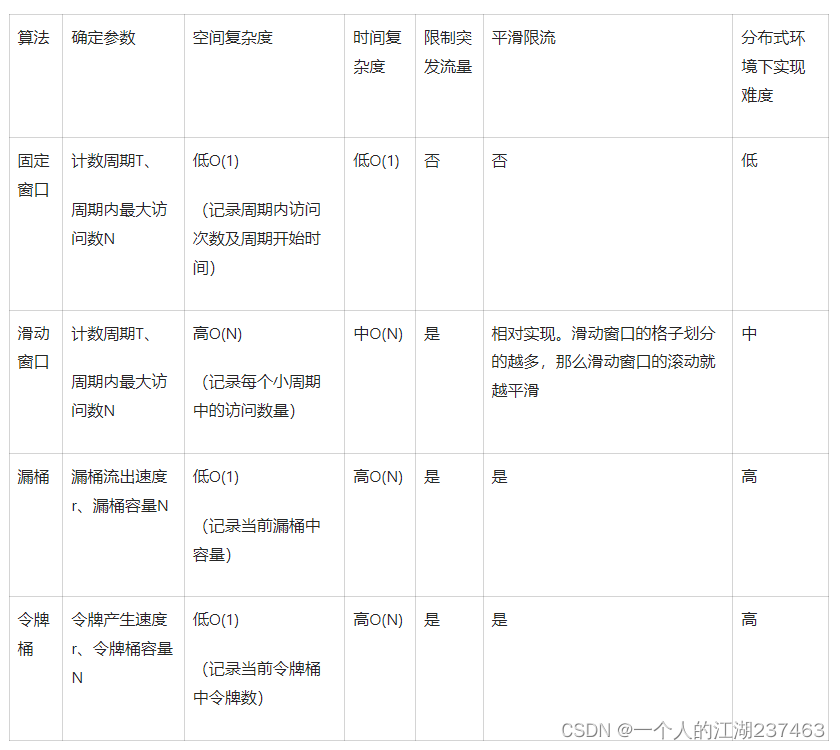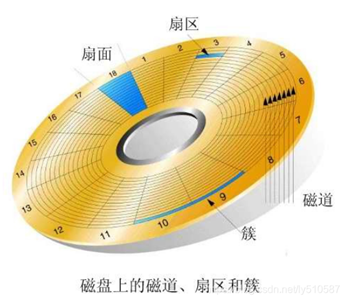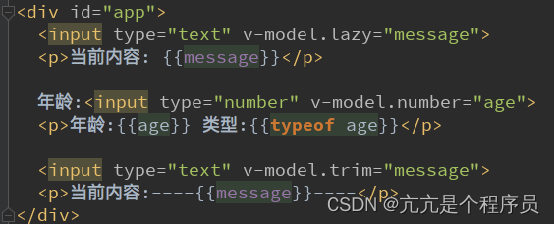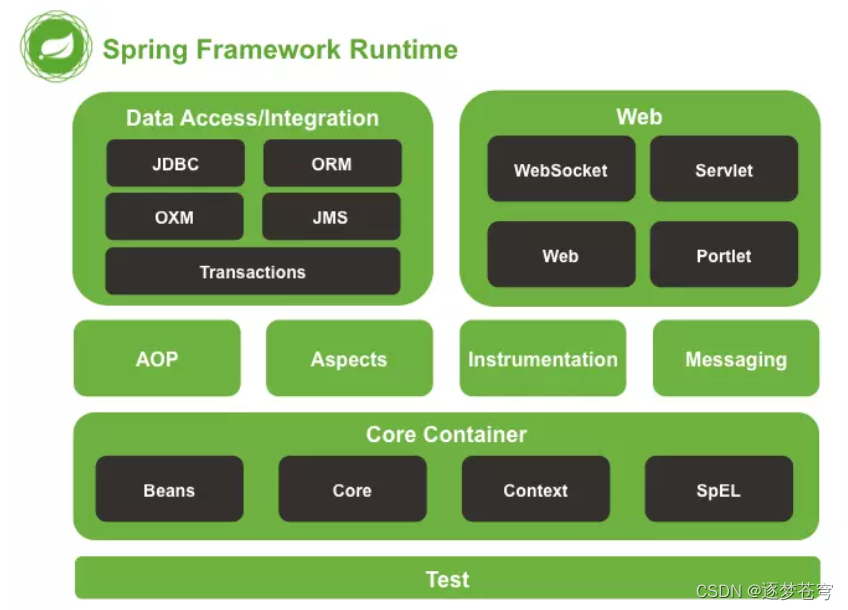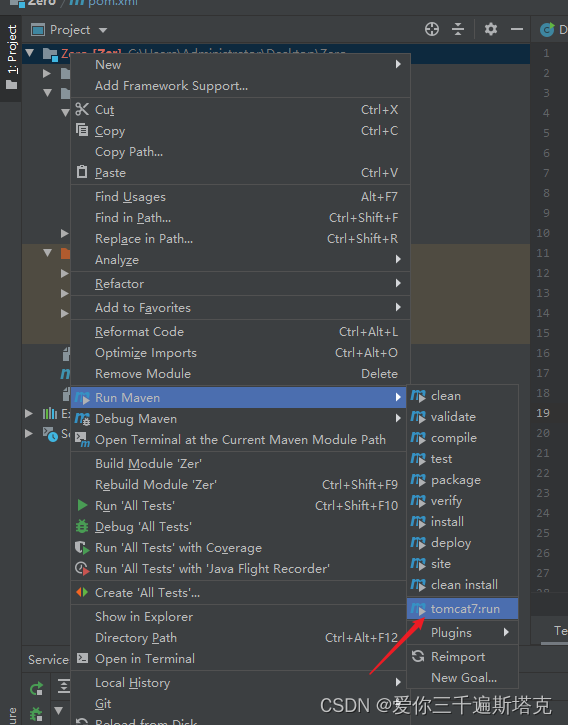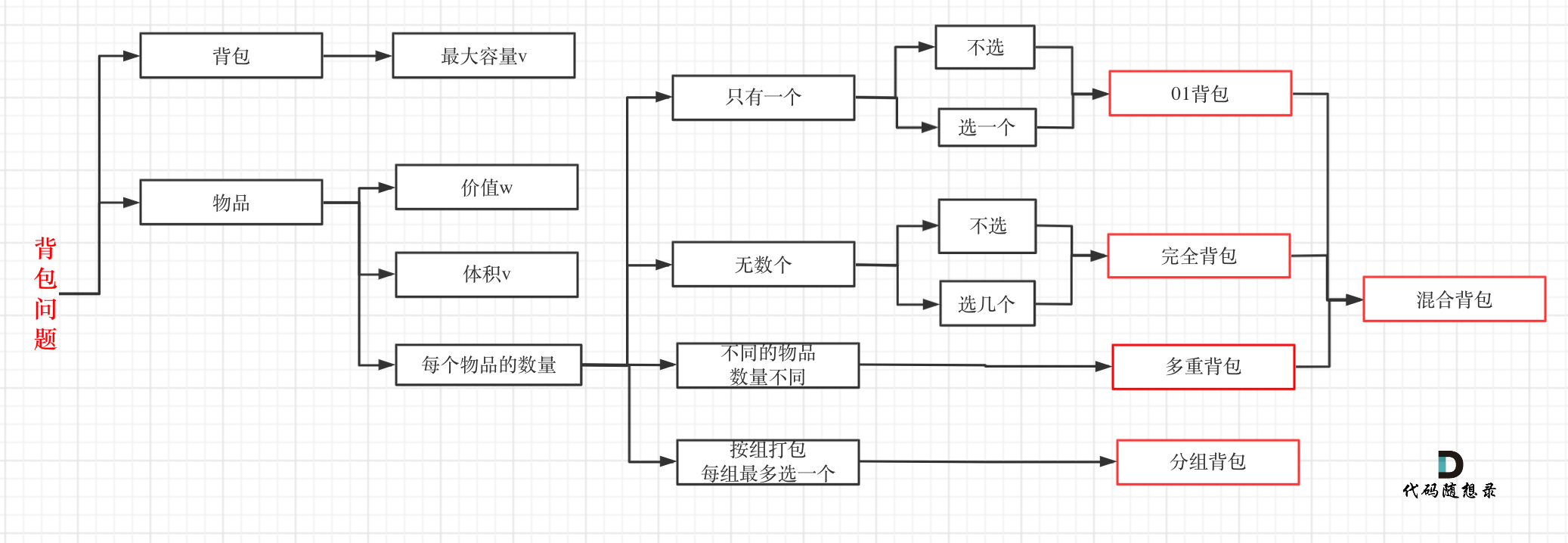目录
- AVL树的概念
- AVL树节点的定义
- AVL树的插入
- AVL树的旋转
- 左单旋(parent->_bf == 2 && cur->_bf == 1)
- a,b,c当高度为0
- a,b,c当高度为1
- a,b,c当高度为2
- a,b,c当高度为......
- 右单旋(parent->_bf == -2 && cur->_bf == -1)
- a,b,c当高度为0
- a,b,c当高度为1
- a,b,c当高度为2
- a,b,c当高度为........
- 左右双旋(parent->_bf == -2 && cur->_bf == 1)
- a,b,c当高度为0
- a,b,c当高度为1
- a,b,c当高度为2
- a,b,c当高度为.......
- 右左双旋(parent->_bf == 2 && cur->_bf == -1)
- a,b,c当高度为0
- a,b,c当高度为1
- a,b,c当高度为2
- a,b,c当高度为.......
- AVL树的性能
AVL树的概念
二叉搜索树虽可以缩短查找的效率,但如果数据有序或接近有序二叉搜索树将退化为单支树,查找元素相当于在顺序表中搜索元素,效率低下。因此,两位俄罗斯的数学家G.M.Adelson-Velskii和E.M.Landis在1962年
发明了一种解决上述问题的方法:当向二叉搜索树中插入新结点后,如果能保证每个结点的左右子树高度之差的绝对值不超过1 (高度差= 右子树高度 - 左子树高度) ,如果超过1需要对树中的结点进行调整,即可降低树的高度,从而减少平均搜索长度。
为什么左右高度差不是相等呢?
因为有些结点数量是永远不能保证高度差相等的比如2个,4个… 所以只能退而求其次,左右高度差不超过1.。
🔍一棵AVL树或者是空树,或者是具有以下性质的二叉搜索树:
- 它的左右子树都是AVL树
- 左右子树高度之差(简称平衡因子)的绝对值不超过1(-1/0/1)
- 每个子树也都要遵守左右子树高度之差的绝对值不超过1
- AVL树的实现不一定必须要用平衡因子,平衡因子只是它的一种实现方式,个人感觉平衡因子比较容易理解AVL树

如果一棵二叉搜索树是高度平衡的,它就是AVL树。如果它有n个结点,其高度可保持在
O
(
l
o
g
2
n
)
O(log_2 n)
O(log2n),搜索时间复杂度O(
l
o
g
2
n
log_2 n
log2n)。
一个正常的平衡二叉搜索树的的平衡因子只能是-1 0 1
AVL树节点的定义
template <class K,class V>
struct AVLTreeNode
{
AVLTreeNode<K, V>* _left;
AVLTreeNode<K, V>* _right;
AVLTreeNode<K, V>* _parent;
pair<K, V> _kv;
int _bf;//平衡因子
AVLTreeNode(const pair<K, V>& kv)
:_left(nullptr)
,_right(nullptr)
,_parent(nullptr)
,_kv(kv)
,_bf(0)//新插入的结点,没有左右子树,所以平衡因子为0
{}
};
template <class K, class V>
class AVLTree
{
typedef AVLTreeNode<K, V> Node;
public:
bool Insert(const pair<K, V>& kv);
private:
Node* _root = nullptr;
};
AVL树的插入
🔍 AVL树就是在二叉搜索树的基础上引入了平衡因子,因此AVL树也可以看成是二叉搜索树。那么AVL树的插入过程可以分为几步:
- 按照二叉搜索树的方式插入新节点
- 更新平衡因子
- 如果更新完以后,平衡因为没有出现问题 ∣ b f ∣ < = 1 |bf| <= 1 ∣bf∣<=1,平衡结构没有受到影响,不需要处理
- 如果更新完以后,平衡出现问题 ∣ b f ∣ > 1 |bf|> 1 ∣bf∣>1,平衡结构受到影响, 需要处理(旋转)

🔍 插入新增节点,会影响祖先的平衡因子(全部或者部分)
- 新增结点在parent左边
cur == parent->_left) parent->_bf-- - 新增结点在parent右边
cur == parent->_right parent->_bf++
🔍 每增加一个结点,就要检查parent所在的子树高度是否变化? 变了继续更新,不变则不再更新。
- 新增结点后,如果parent的平衡因子等于1或者-1,parent所在的子树高度变了,需要继续向上更新平衡因子。为什么呢?因为在插入结点之前parent的平衡因子等于0,说明插入之前左右两个子树高度相等,现在parent一边高一边低,高度发生变化需要继续向上更新平衡因子。
- 新增结点后,如果parent的平衡因子等于2或者-2,parent所在的子树高度不平衡了,需要处理这个子树(进行旋转)。
- 新增结点后,如果parent的平衡因子等于0,parent所在的子树高度不变,不需要处理继续向上更新,这一次插入结束。为什么呢?说明插入之前parent的平衡因子等于1或者-1,插入之前parent一边高一边低,插入的结点填在了矮的那一边,它的高度不变。
bool Insert(const pair<K, V>& kv)
{
if (nullptr == _root)//第一次插入
{
_root = new Node(kv);
return true;
}
//插入的树不是空树
Node* parent = nullptr;
Node* cur = _root;
while (cur)
{
if (cur->_kv.first < kv.first)
{
parent = cur;
cur = cur->_right;
}
else if (cur->_kv.first > kv.first)
{
parent = cur;
cur = cur->_left;
}
else
{
//不支持重复数据
return false;
}
}
//插入数据
cur = new Node(kv);
if (parent->_kv.first < cur->_kv.first)
{
parent->_right = cur;
}
else
{
parent->_left = cur;
}
//链接父结点
cur->_parent = parent;
//更新平衡因子
//父结点的平衡因子 = 左子树高度 - 右子树高度
while (parent)//终止条件,根结点的父结点为空
{
if (cur == parent->_left)
{
parent->_bf--;
}
else
{
parent->_bf++;
}
if (parent->_bf == 1 || parent->_bf == -1)
{
parent = parent->_parent;
cur = cur->_parent;
}
else if (parent->_bf == 0)
{
break;
}
else if (parent->_bf == 2 || parent->_bf == -2)
{
// 需要旋转处理 -- 1、让这颗子树平衡 2、降低这颗子树的高度
if (parent->_bf == 2 && cur->_bf == 1)
{
RotateL(parent);
}
else if (parent->_bf == -2 && cur->_bf == -1)
{
RotateR(parent);
}
else if (parent->_bf == -2 && cur->_bf == 1)
{
RotateLR(parent);
}
else if (parent->_bf == 2 && cur->_bf == -1)
{
RotateRL(parent);
}
else
{
//说明这个AVL树存在问题
assert(false);
}
break;
}
else
{
//说明这个AVL树存在问题
assert(false);
}
}
return true;
}
AVL树的旋转
💡旋转的原则:保持他继续是搜索树。
💡旋转的目的:左右均衡,降低整棵树的高度。
🔍如果在一棵原本是平衡的AVL树中插入一个新节点,可能造成不平衡,此时必须调整树的结构,使之平衡化。根据节点插入位置的不同,AVL树的旋转分为四种:
左单旋(parent->_bf == 2 && cur->_bf == 1)

a,b,c当高度为0

a,b,c当高度为1

a,b,c当高度为2
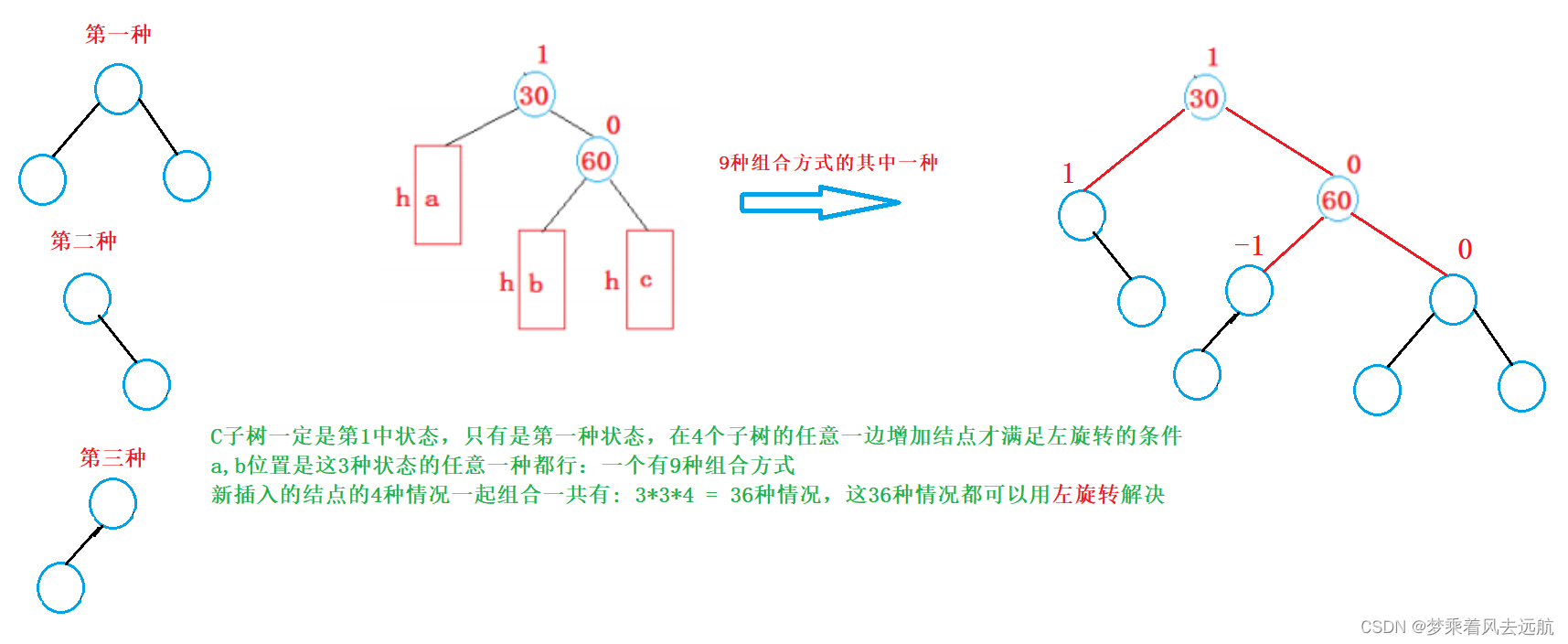
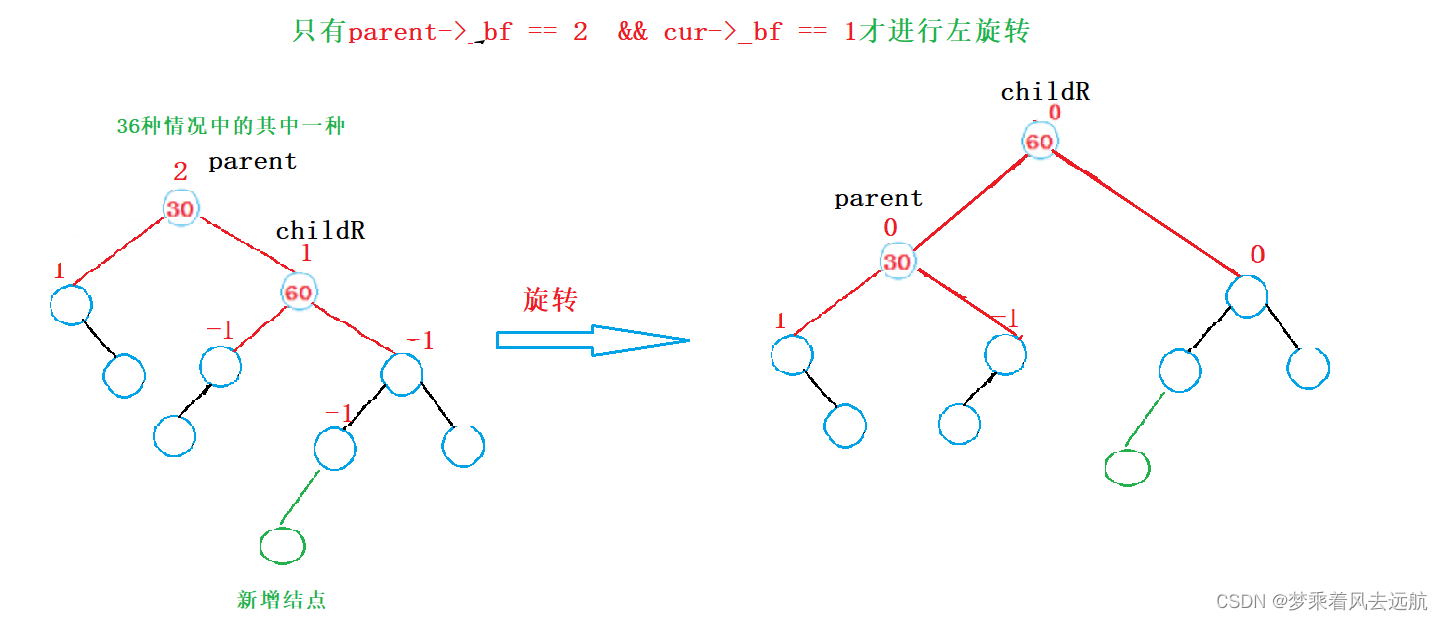
a,b,c当高度为…
后面的情况就不画了情况太多了。只要符合parent->_bf == 2 && cur->_bf == 1的子树和根都可以进行左单旋。
💻左单旋代码
//右子树高,进行左单旋
void RotateL(Node* parent)
{
Node* childR = parent->_right;
Node* childRL = childR->_left;
parent->_right = childRL;
if (childRL)//如果childRL不为空,要链接父节点
childRL->_parent = parent;
Node* pparent = parent->_parent;
childR->_left = parent;
parent->_parent = childR;
if (nullptr == pparent)//说明是根结点
{
_root = childR;
//_root->_parent = nullptr;
childR->_parent = nullptr;
}
else
{
//判断是pparent的左子树还是右子树
if (pparent->_left == parent)
{
pparent->_left = childR;
}
else
{
pparent->_right = childR;
}
childR->_parent = pparent;//链接父结点
}
parent->_bf = childR->_bf = 0;//更新平衡因子
}
右单旋(parent->_bf == -2 && cur->_bf == -1)
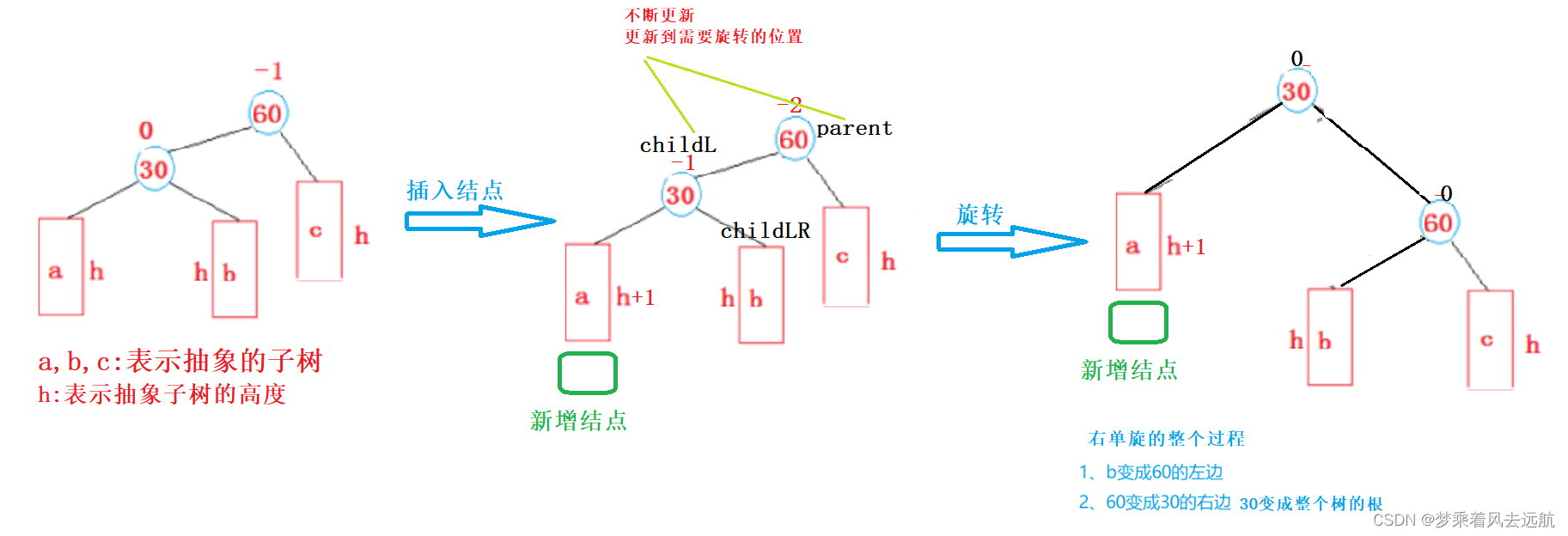
a,b,c当高度为0

a,b,c当高度为1
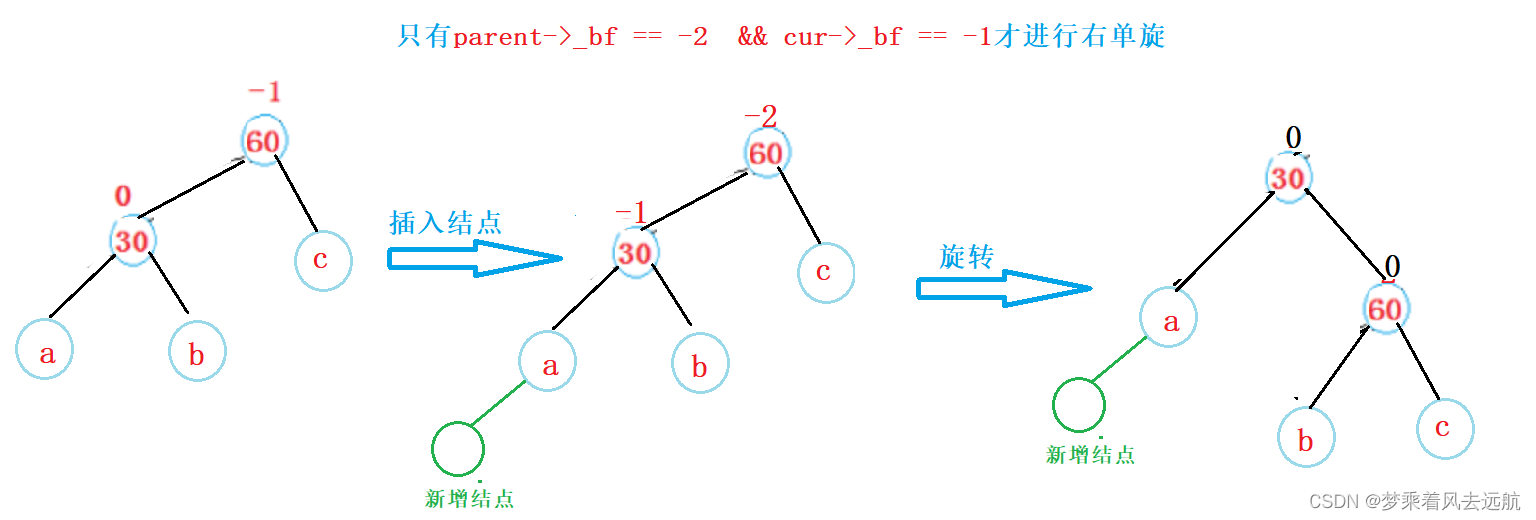
a,b,c当高度为2


a,b,c当高度为…
后面的情况就不画了情况太多了。只要符合parent->_bf == -2 && cur->_bf == -1的子树和根都可以进行右单旋。
💻右单旋代码
//左子树高,进行右单旋
void RotateR(Node* parent)
{
Node* childL = parent->_left;
Node* childLR = childL->_right;
parent->_left = childLR;
if (childLR)
childLR->_parent = parent;
Node* pparent = parent->_parent;
childL->_right = parent;
parent->_parent = childL;
if (_root == parent)//说明是根结点
{
_root = childL;
_root->_parent = nullptr;
}
else
{
//判断是pparent的左子树还是右子树
if (pparent->_left == parent)
{
pparent->_left = childL;
}
else
{
pparent->_right = childL;
}
childL->_parent = pparent;//链接父结点
}
parent->_bf = childL->_bf = 0;//更新平衡因子
}
左右双旋(parent->_bf == -2 && cur->_bf == 1)
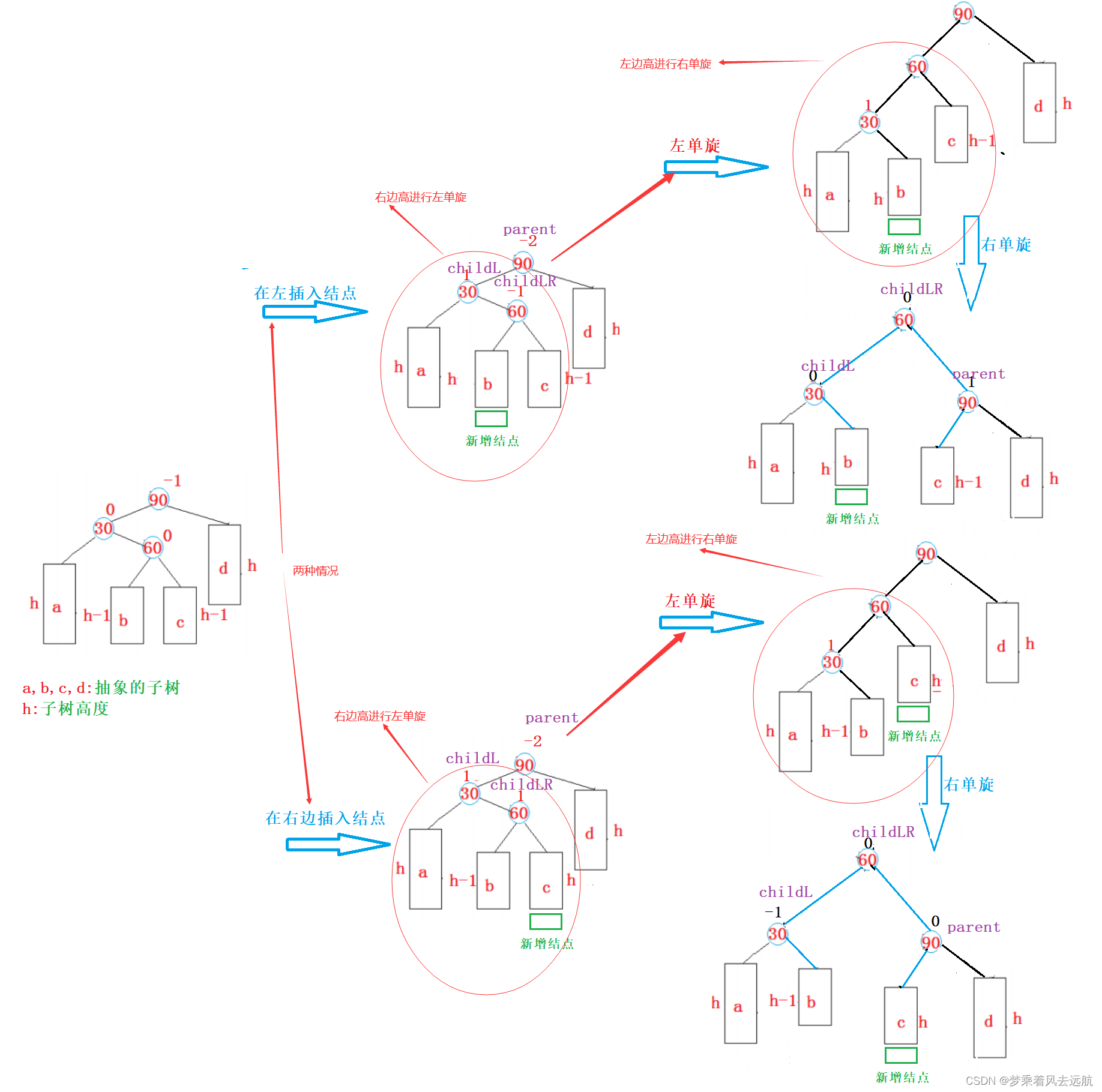
a,b,c当高度为0

a,b,c当高度为1
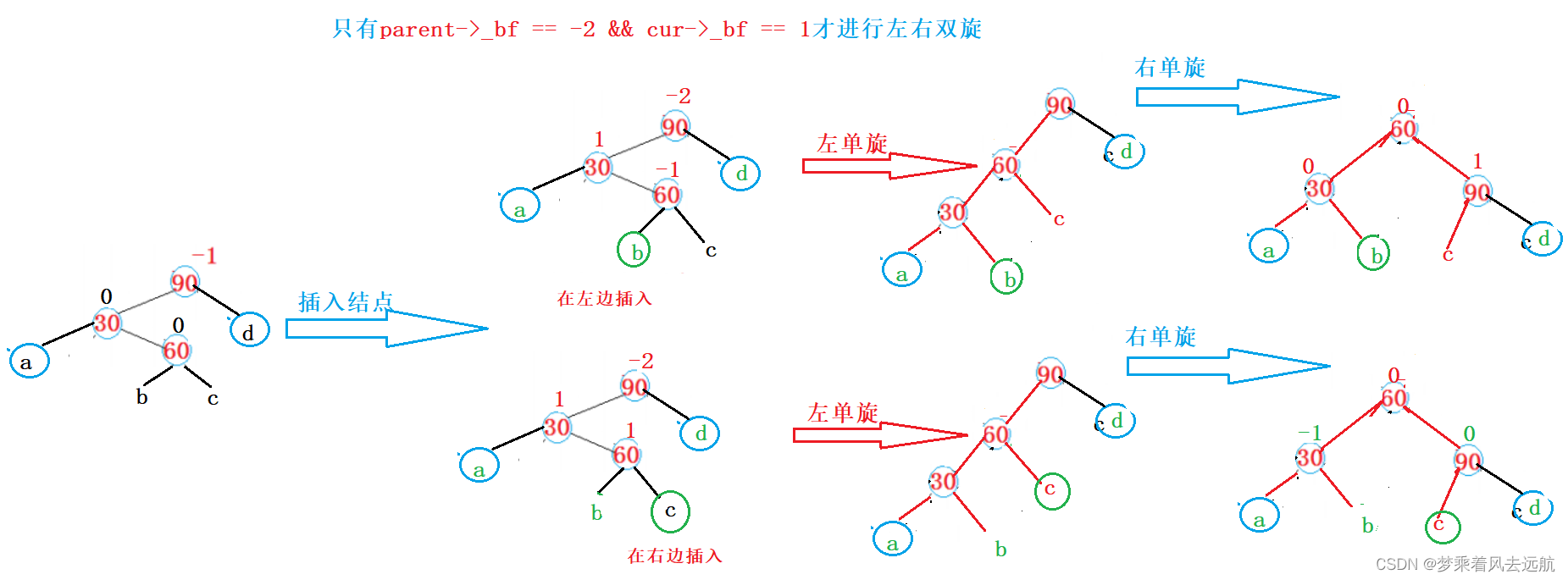
a,b,c当高度为2
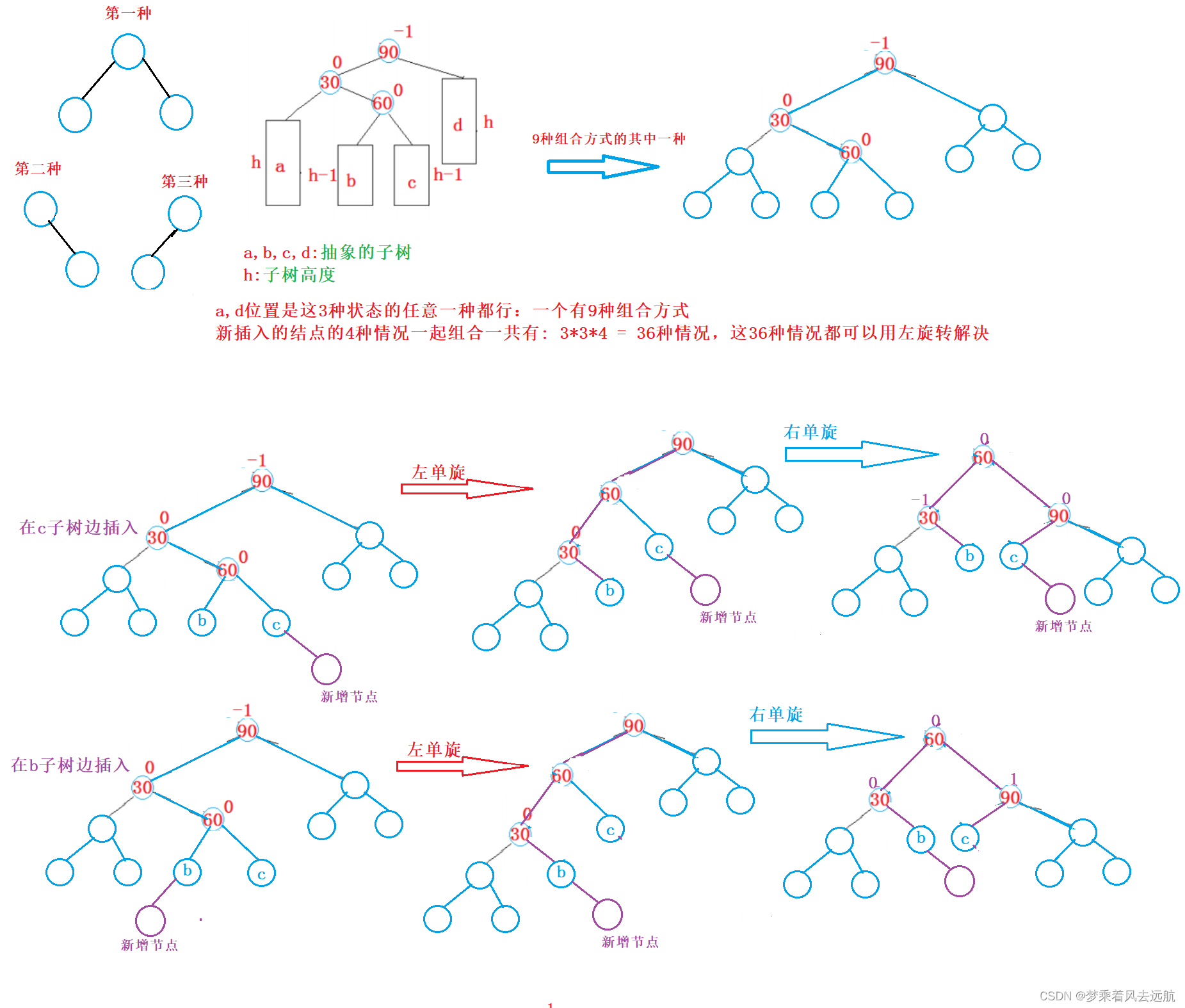
a,b,c当高度为…
后面的情况就不画了情况太多了。只要符合parent->_bf == -2 && cur->_bf == 1`的子树和根都可以进行左右双旋。
💻左右双旋代码
//左子树的右子树高,进行左右双旋
void RotateLR(Node* parent)
{
Node* childL = parent->_left;
Node* childLR = childL->_right;
int bf = childLR->_bf;//bf有三种情况
RotateL(parent->_left);
RotateR(parent);
if (bf == 1)//bf == 1代表新增加结点是childLR的左子树
{
parent->_bf = 0;
childLR->_bf = 0;
childL->_bf = -1;
}
else if (bf == -1)//bf == -1代表新增加结点是childLR的右子树
{
parent->_bf = 1;
childLR->_bf = 0;
childL->_bf = 0;
}
else if (bf == 0)//bf == 0代表新增加结点是childLR,使平衡因子发生错误
{
parent->_bf = 0;
childLR->_bf = 0;
childL->_bf = 0;
}
else
{
assert(false);
}
}
右左双旋(parent->_bf == 2 && cur->_bf == -1)
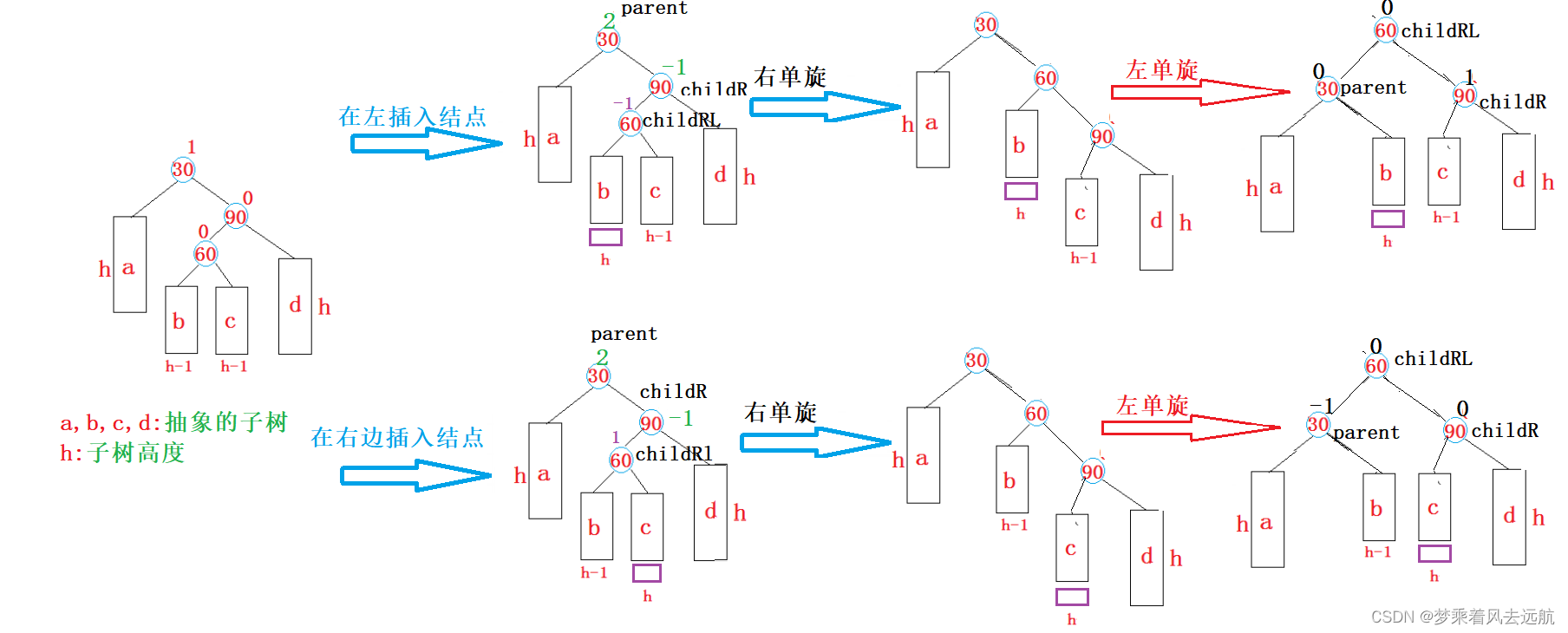
a,b,c当高度为0

a,b,c当高度为1
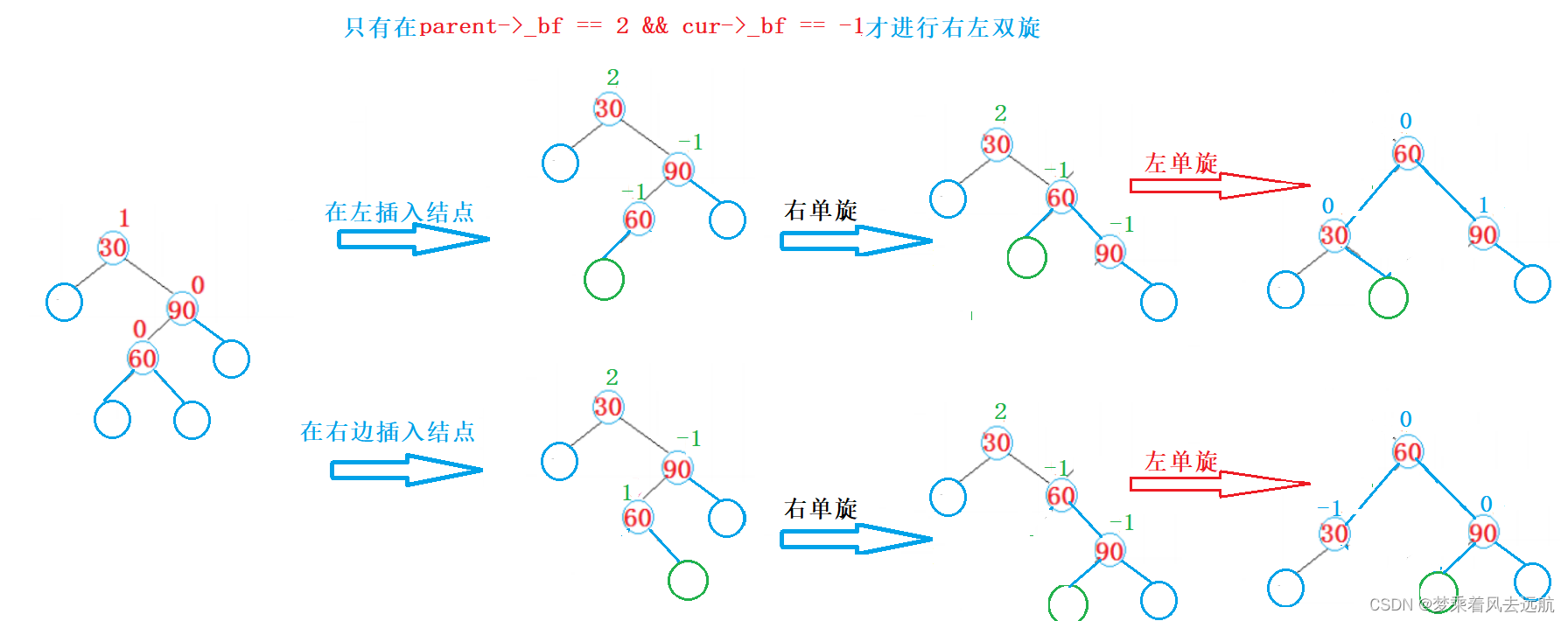
a,b,c当高度为2
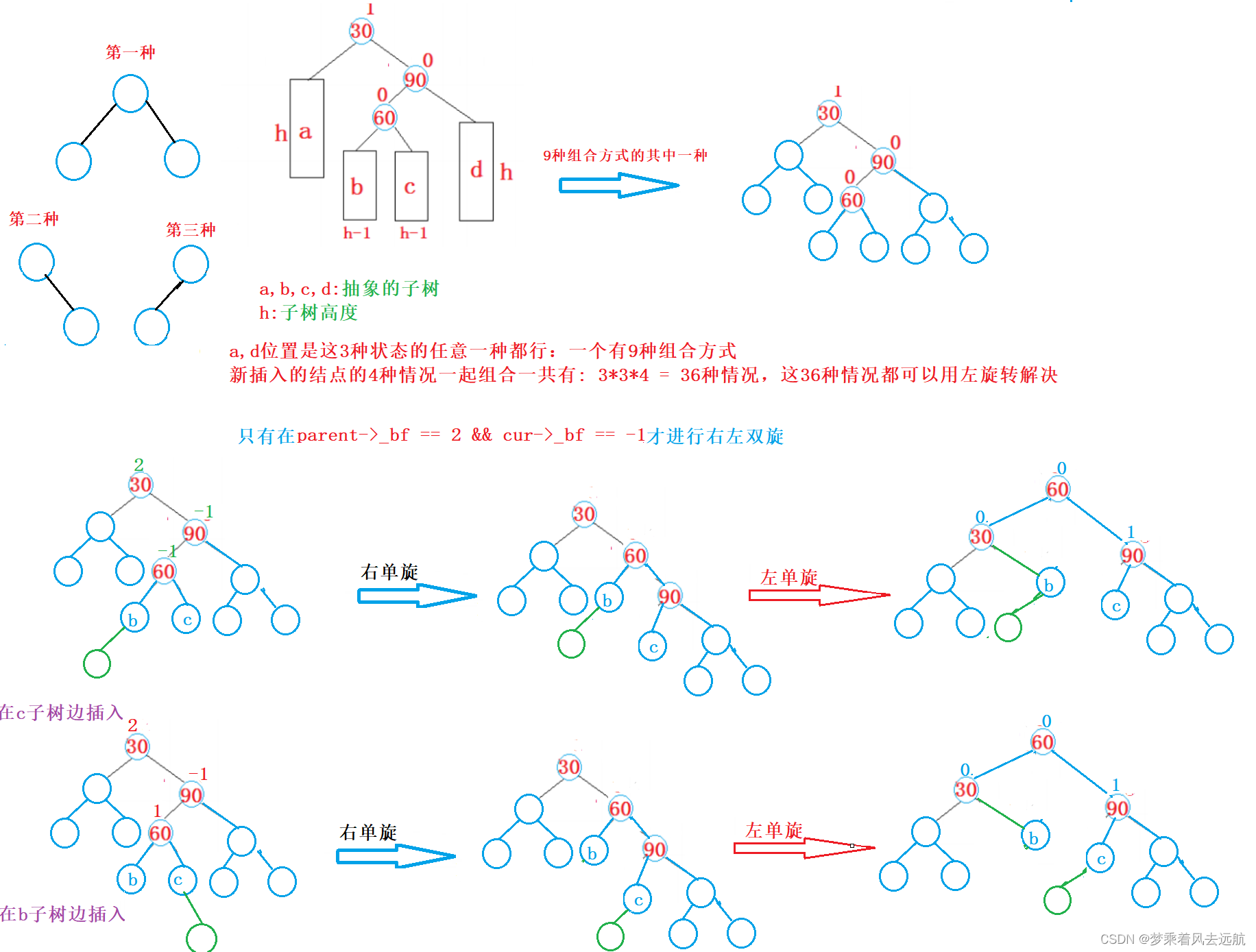
a,b,c当高度为…
后面的情况就不画了情况太多了。只要符合parent->_bf == 2 && cur->_bf == -1的子树和根都可以进行右左双旋。
💻右左双旋代码
//右子树的左子树高,进行右左双旋
void RotateRL(Node* parent)
{
Node* childR = parent->_right;
Node* childRL = childR->_left;
int bf = childRL->_bf;//bf有三种情况
RotateR(parent->_right);
RotateL(parent);
if (bf == 1)
{
parent->_bf = -1;
childR->_bf = 0;
childRL->_bf = 0;
}
else if (bf == -1)
{
parent->_bf = 0;
childR->_bf = 1;
childRL->_bf = 0;
}
else if (bf == 0)
{
parent->_bf = 0;
childR->_bf = 0;
childRL->_bf = 0;
}
else
{
assert(false);
}
}
AVL树的性能
AVL树是一棵绝对平衡的二叉搜索树,其要求每个节点的左右子树高度差的绝对值都不超过1,这样可以保证查询时高效的时间复杂度,即 l o g 2 ( N ) log_2 (N) log2(N)。但是如果要对AVL树做一些结构修改的操作,性能非常低下,比如:插入时要维护其绝对平衡,旋转的次数比较多,更差的是在删除时,有可能一直要让旋转持续到根的位置。因此:如果需要一种查询高效且有序的数据结构,而且数据的个数为静态的(即不会改变),可以考虑AVL树,但一个结构经常修改,就不太适合。
